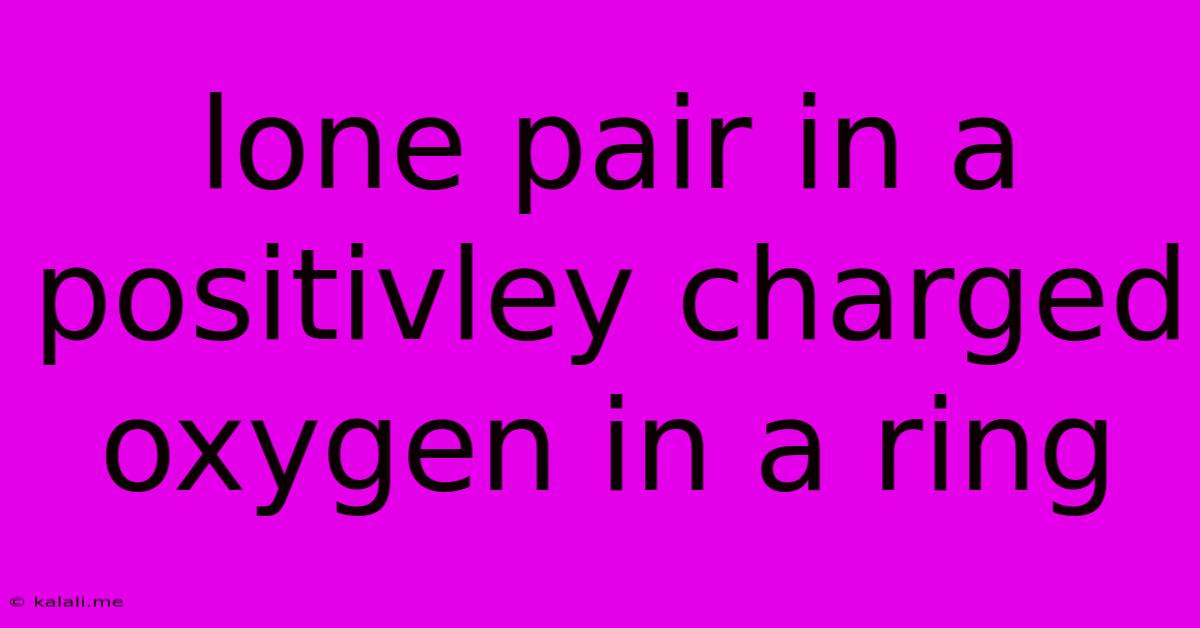Lone Pair In A Positivley Charged Oxygen In A Ring
Kalali
May 23, 2025 · 3 min read

Table of Contents
Lone Pairs in Positively Charged Oxygen in a Ring: A Deeper Dive into Organic Chemistry
Meta Description: Explore the unusual chemistry of positively charged oxygen in a ring system. This article delves into the impact on lone pairs, stability, and reactivity, providing insights into advanced organic concepts.
Positively charged oxygen, or oxonium ions, are relatively uncommon in organic chemistry compared to their negatively charged counterparts (alkoxides). However, when incorporated into a ring system, their behavior and properties become particularly interesting, especially regarding the lone pairs on the oxygen atom. This article will explore the nuances of lone pairs in positively charged oxygen within a ring structure, considering their impact on stability, reactivity, and overall molecular behavior.
Understanding Oxonium Ions in Rings
An oxonium ion is formed when an oxygen atom gains a positive charge, typically through protonation or alkylation. In a ring system, this positively charged oxygen becomes part of the cyclic structure, significantly affecting its electronic environment and the availability of its lone pairs. The ring size and the nature of other substituents on the ring play crucial roles in determining the stability and reactivity of the oxonium ion.
For instance, consider a cyclic ether, such as tetrahydrofuran (THF). Protonation of the oxygen atom creates a positively charged oxonium ion. In this case, the lone pairs on the oxygen are significantly involved in bonding, resulting in a change in the hybridization and geometry around the oxygen. The previously sp3 hybridized oxygen becomes sp3 hybridized but with a formal positive charge. This change affects the electron density and thus, the reactivity.
Impact on Lone Pairs
The key to understanding the behavior of a positively charged oxygen in a ring lies in appreciating the fate of its lone pairs. Before protonation, oxygen possesses two lone pairs, which contribute to its basicity and nucleophilicity. Upon protonation, one lone pair is used to form a bond with the proton (H+), leaving only one lone pair. This lone pair is still involved in resonance interactions within the ring, influencing the overall electronic distribution.
The impact of this lone pair depends heavily on the ring's size and substituents:
-
Ring Size: Smaller rings (e.g., three-membered oxiranium ions) impose significant ring strain, reducing the stability of the oxonium ion and altering the lone pair's reactivity. Larger rings experience less strain, leading to different stability and reactivity profiles.
-
Substituents: Electron-donating groups on the ring can stabilize the positive charge on the oxygen, while electron-withdrawing groups destabilize it. This impacts the availability and reactivity of the remaining lone pair.
-
Resonance Effects: If the ring incorporates conjugated systems (e.g., aromatic rings), the lone pair can participate in resonance, delocalizing the positive charge and affecting the overall reactivity.
Reactivity and Stability Considerations
The presence of a positively charged oxygen in a ring significantly alters the molecule's reactivity. The reduced number of lone pairs and the overall positive charge influence its susceptibility to nucleophilic attack and other reactions. The stability of the oxonium ion is also a crucial factor; less stable oxonium ions are more reactive and prone to rapid deprotonation.
Examples and Applications
While not commonly found as stable intermediates, these oxonium ions are crucial intermediates in many organic reactions, including:
-
Electrophilic additions: In certain reactions, the oxonium ion acts as an electrophile, readily reacting with nucleophiles.
-
Ring-opening reactions: The positive charge increases the susceptibility of the ring to nucleophilic attack, leading to ring-opening reactions.
-
Acetal and ketal formation: The protonated oxygen in cyclic acetals and ketals plays a crucial role in their formation and stability.
Conclusion
The behavior of lone pairs in positively charged oxygen within ring systems is a complex area influenced by a multitude of factors. Understanding these influences is critical for predicting the reactivity and stability of such molecules and for designing synthetic pathways involving these important intermediates. Further research into this area will undoubtedly reveal even more fascinating and subtle aspects of this often overlooked area of organic chemistry.
Latest Posts
Latest Posts
-
What Is Used To Hold Two Peices Of Stripped Wood
May 23, 2025
-
Cen You Have Have Camera Lenses Fixed
May 23, 2025
-
How To Fix Screws On Vinyl Window
May 23, 2025
-
What Crime Does Covering Up A Murder Charge
May 23, 2025
-
Open Hand Attack Dnd 5e Equal
May 23, 2025
Related Post
Thank you for visiting our website which covers about Lone Pair In A Positivley Charged Oxygen In A Ring . We hope the information provided has been useful to you. Feel free to contact us if you have any questions or need further assistance. See you next time and don't miss to bookmark.